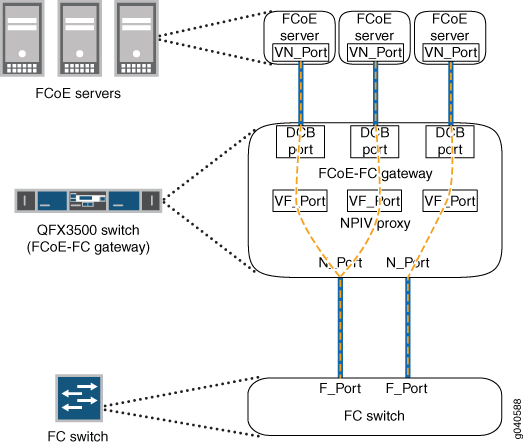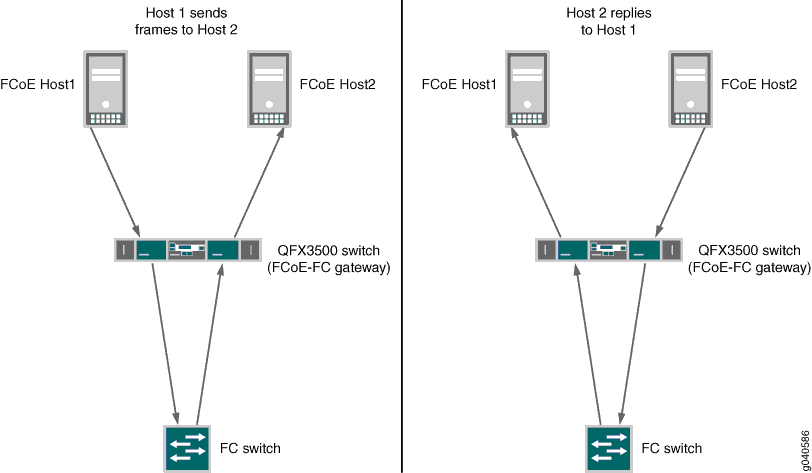Understanding an FCoE-FC Gateway
A Fibre Channel over Ethernet (FCoE)-Fibre Channel (FC) gateway connects FCoE devices on an Ethernet network to an FC switch in an FC storage area network (SAN) as shown in Figure 1. To FCoE devices such as servers, the FCoE-FC gateway presents virtual fabric ports (VF_Ports) and appears to be an FCoE forwarder (FCF). To the FC switch, the FCoE-FC gateway presents a proxy node port (NP_Port) and appears to be an FC device. Only the QFX3500 switch, both in standalone mode and as a QFabric system Node device, supports configuration as an FCoE-FC gateway.

The FCoE-FC gateway handles FCoE Initialization Protocol (FIP) and FCoE traffic on the interfaces connected to FCoE devices. The gateway forwards native FC traffic on the interfaces to the FC switch. The gateway does not provide FC services (such as fabric login server or name server). It is a proxy for an FCF, not an FCF or an FC switch. The gateway transparently substitutes for the FC switch when communicating with FCoE devices and transparently substitutes for FCoE devices when communicating with the FC switch.
The gateway does not use an FC domain ID, so it extends the SAN fabric while saving domain resources. Using the gateway also means that the FC switch does not have to handle FCoE traffic (and therefore requires no FCoE blades or ports). The gateway converges Ethernet and FC backbones to leverage existing resources.
Gateway FC Fabric
A gateway FC fabric is a QFX3500 configuration construct. It is not the same thing as an FC fabric in the SAN; the gateway FC fabric is local to the switch. It creates associations that connect FCoE devices with converged network adapters (CNAs) on the Ethernet network to an FC switch on the Fibre Channel network. A gateway FC fabric consists of:
-
A unique fabric name.
-
A unique fabric ID.
-
At least one dedicated VLAN for FCoE traffic. VLANs that carry FCoE traffic should not carry any other type of traffic.
Note:On a QFX3500 or QFabric system QFX3500 Node device, the same VLAN cannot be used in both transit switch mode and FCoE-FC gateway mode.
-
At least one FCoE VLAN interface (Layer 3 VLAN interface) that includes one or more 10-Gigabit Ethernet interfaces connected to FCoE devices. The FCoE VLANs transport traffic between the FCoE servers and the FCoE-FC gateway. Each FCoE VLAN must carry only FCoE traffic. You cannot mix FCoE traffic and standard Ethernet traffic on the same VLAN.
The 10-Gigabit Ethernet interfaces that connect to FCoE devices must include a native VLAN to transport FIP traffic because FIP VLAN discovery and notification frames are exchanged as untagged packets.
Each FCoE VLAN interface can present multiple VF_Port interfaces to the FCoE network.
Note:Storm control must be disabled on all Ethernet interfaces that belong to the FCoE VLAN to prevent FCoE traffic from being dropped.
-
One or more native FC interfaces. The native FC interfaces transport traffic between the gateway and the FC switch.
Tip:If the network does not use a dual-rail architecture for redundancy, configure more than one native FC interface for each FC fabric to create redundant connections between the FCoE devices and the FC switch. If one physical link goes down, any sessions it carried can log in again and connect to the FC switch on a different interface. Even in dual-rail architecture networks, creating redundant connections between the QFabric system and the FC switch is the best practice.
You can also configure FIP parameters for the fabric or accept the default FIP parameters. VN_Port to VF_Port (VN2VF_Port) FIP snooping is automatically enabled on all server-facing ports because all ports are untrusted by default. You can disable VN2VF_Port FIP snooping on a port-by-port basis by marking a port as an FCoE trusted interface. You can disable VN2VF_Port FIP snooping on all Ethernet ports in an FC fabric by configuring the fabric as FCoE trusted.
Because the switch has 12 native FC ports and each FC fabric requires a minimum of one native FC port, the switch supports a maximum of 12 FC fabrics. However, as a best practice for redundancy, we recommend that you assign at least two native FC interfaces to each FC fabric.
On a QFabric system, all of the FC and FCoE traffic that belongs to a particular gateway FC fabric must ingress and egress the same gateway Node device. Gateway FC fabrics do not span across Node devices. All of the native FC interfaces and the Ethernet interfaces that belong to the FCoE VLAN must reside on the same gateway Node device to be included in an FC fabric on that Node device.
Traffic from FC and FCoE devices that are not in the same FC fabric remain separate and cannot communicate with each other through the gateway.
Fabric Services
The FC switch provides all FC services (domain manager, name server, fabric login server, and so on) except FIP to the FCoE devices. The FC switch assigns all FCIDs (through N_Port ID virtualization) and fabric attributes to FCoE device VN_Ports.
The FCoE-FC gateway does not provide FC services (except FIP). The gateway relays communication between the FC switch and the FCoE devices, encapsulates and de-encapsulates native FC frames, converges Ethernet and FC backbones, and aggregates FCoE device VN_Port sessions.
FCoE-FC Gateway Traffic Switching
All traffic that flows through the gateway FC fabric is switched through the FC switch. Even if two hosts on the Ethernet FCoE network connect directly to the gateway, FCoE communication between them goes through the FC switch, as shown in Figure 2.

For example, FCoE host server Host1 sends frames destined for FCoE host server Host2. Both Host1 and Host2 are directly connected to the gateway. The communication path looks like this:
-
Host1 sends FCoE frames destined for Host2 to the gateway .
-
The gateway de-encapsulates the FCoE frames from Host1 into native FC frames and switches them to the FC switch.
-
The FC switch processes the native FC frames and sends them back to the gateway destined for Host2.
-
The gateway encapsulates the FC frames in Ethernet and sends the resulting FCoE frames to Host2.
-
When Host2 replies, the FCoE reply goes to the gateway. The gateway de-encapsulates the reply and switches it to the FC switch for processing. The FC switch then sends it back to the gateway, which encapsulates the FC frames and sends them to Host1.
